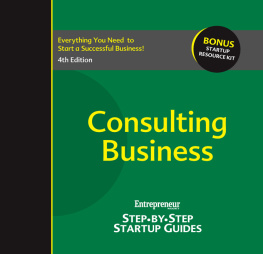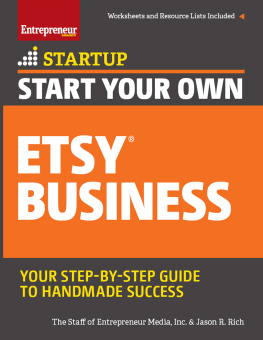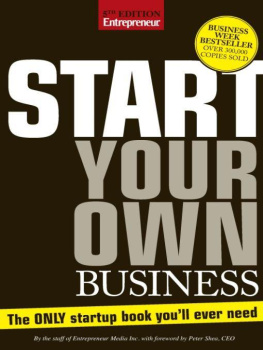
Entrepreneur Press, Publisher
Cover Design: Andrew Welyczko
Production and Composition: Eliot House Productions
2015 by Entrepreneur Media, Inc.
All rights reserved.
Reproduction or translation of any part of this work beyond that permitted by Section 107 or 108 of the 1976 United States Copyright Act without permission of the copyright owner is unlawful. Requests for permission or further information should be addressed to the Business Products Division, Entrepreneur Media Inc.
This publication is designed to provide accurate and authoritative information in regard to the subject matter covered. It is sold with the understanding that the publisher is not engaged in rendering legal, accounting or other professional services. If legal advice or other expert assistance is required, the services of a competent professional person should be sought.
Library of Congress Cataloging-in-Publication Data
Write your business plan: get your plan in place and your business off the ground / by The Staff of Entrepreneur Media, Inc.
pages. cm.
Includes index.
ISBN-13: 978-1-61308-301-7
1. Business planning. 2. New business enterprisesManagement. 3. Small businessManagement. I. Entrepreneur Media, Inc.
HD30.28.W754 2015
658.4'012dc23 2014035844
19 18 17 16 15 | 10 9 8 7 6 5 4 3 2 1 |
Contents
I n the early 1950s, all Ray Kroc could think about was selling food mixers. By 1954, he had failed at just about every job he had hadpiano player, paper-cup salesman, ambulance driver. And at the age of 52, he wanted to do something different.
One of his customers, a small hamburger joint in San Bernardino, California, caught his eye. Instead of buying a single mixer, this tiny restaurant, owned by brothers Dick and Mac McDonald, bought eight. The restaurant was simple. It didnt serve much more than a hamburger, fries, and some drinks.
The McDonald brothers were content. Ray Kroc wasnt.
So he put together a plan.
Kroc believed the hamburger restaurants success could be exported around the country. He saw what the McDonald brothers didnta network of restaurants using the best practices of the San Bernardino location to sell burgers and fries. So he calculated the potential, wrote a proposal, and within a year had formed the McDonalds Corporation, eventually transforming a roadside hamburger joint into an international powerhouse.
It wasnt because Kroc was simply an idea man, an entrepreneur, or visionary. A lot of us have good ideas. Some of us have great ones. But that doesnt mean we can turn those ideas into businesses. What sets the dreamer apart from the doer is the plan. The business plan.
Thats why this book is so important. Entrepreneurship is the lifeblood of the world economy, the process of innovation, disruption, and risk that creates companies each day and drives otherwise normal people to leave their jobs and turn their own inventions or concepts into moneymaking enterprises.
To build a company, though, you need a plan. A real one. A plan that lays out your product, your strategy, your market, your team, and your opportunity. It is your vision. It is the blueprint for your business.
Why do you need a plan? Well, for one thing, someone needs to fund your business, and people dont like parting with dollars unless theyre pretty confident you know what youre doing. That is certainly true of venture capitalists and bankers. Its also true of friends and family. Whether you are borrowing $50,000 or $5 million, your backers want to see real numbers, real projections, and real strategy. Can you blame them? After all, it may be your idea, but its their money.
Still, business plans go beyond simply getting funding. A good leader formulates a plan for herself, making it a living document to help drive the business. It is a sounding board to strategy. Projections change and opportunities and missteps happen. The plan is the course correction, a chart off which to plot next moves, pivots, or future objectives. A good business plan can help you evaluate whether the time is right for an acquisition. It can be a tool in deciding whether to hire or cut staff. It can be a barometer to measure your performance against that of your competitors.
This book will walk you through how to craft the best business plan for your business. From determining the needs of your customer, to explaining your technology, to laying out your strategy, this book is the most comprehensive how-to manual for building your business. We walk you through which financials are important, how to analyze your competition, and what technology is available to assist you in understanding where your company is and where it can go. Whats more, we give you real-world examples of plans that worked, helping to raise money or hone strategy.
Not every business will succeed. In truth, far more businesses fail than succeed. The differentiator is always in the planning. This book gives you that competitive edge.
Ray Kroc saw two things. First, he saw an opportunity that was unmet. More important, he saw a business in need of a planand a leader. Every day, someone wakes up with an idea. You have taken the next, more important step of buying this book to make that idea into a business. I hope you profit from that experience.
Ray Hennessey, Editor, Write Your Business Plan and Editorial Director, Entrepreneur.com
A business plan is a written description of the future of your business. It is a document that tells the story of what you plan to do and how you plan to do it. If you jot down a paragraph on the back of an envelope describing your business strategy, youve written a plan, or at least the germ of a plan.
Business plans are inherently strategic. You start here, today, with certain resources and abilities. You want to get to a there, a point in the future (usually three to five years out) at which time your business will have a different set of resources and abilities as well as greater profitability and increased assets. Your plan shows how you will get from here to there. In essence it is a road map from where you are now to where you want to be later on.
There are some generally accepted conventions about what a full-blown business plan should include and how it should be presented. A plan should cover all the important matters that will contribute to making your business a success. These include the following:
1. Your basic business concept. This is where you discuss the industry, your business structure, your particular product or service, and how you plan to make your business a success.
2. Your strategy and the specific actions you plan to take to implement it. What goals do you have for your business? When and how will you reach your goals?
3. Your products and services and their competitive advantages. Here is your chance to dazzle the readers with good, solid information about your products or services and why customers will want to purchase your products and services and not those of your competitors.
4. The markets youll pursue. Now you have to lay out your marketing plan. Who will your customers be? What is your demographic audience? How will you attract and retain enough customers to make a profit? What methods will you use to capture your audience? What sets your business apart from the competition?
5. The background of your management team and key employees. Having information about key personnel is an important but often misrepresented portion of a business plan. Its not a long and detailed biography of each person involved but an accurate account of what they have done and what they bring to the table for this specific business opportunity.
Next page







